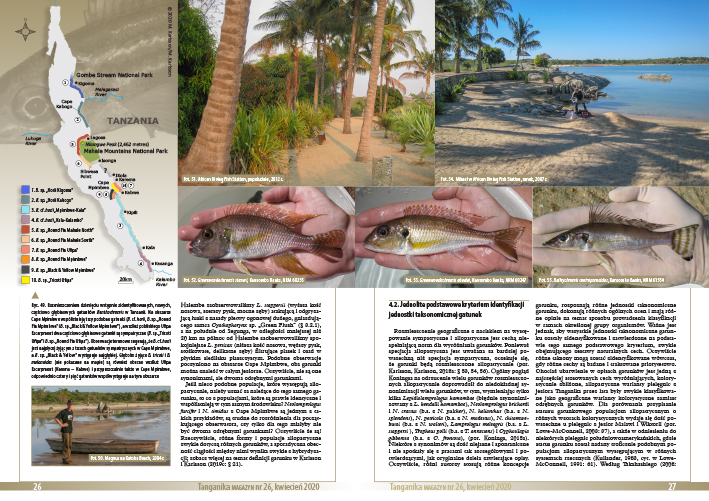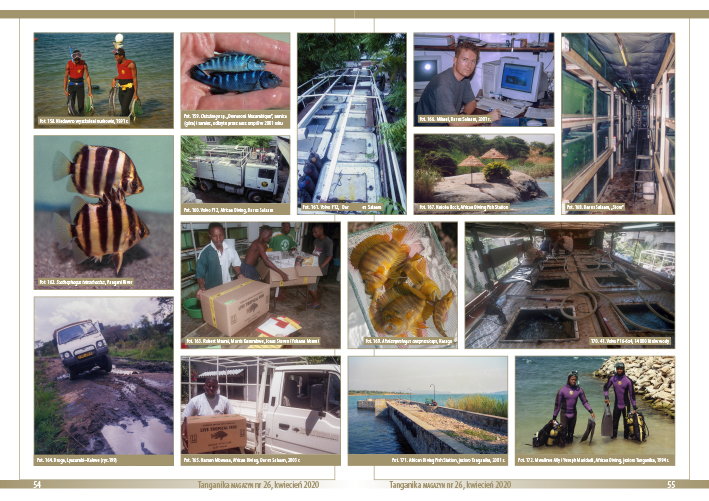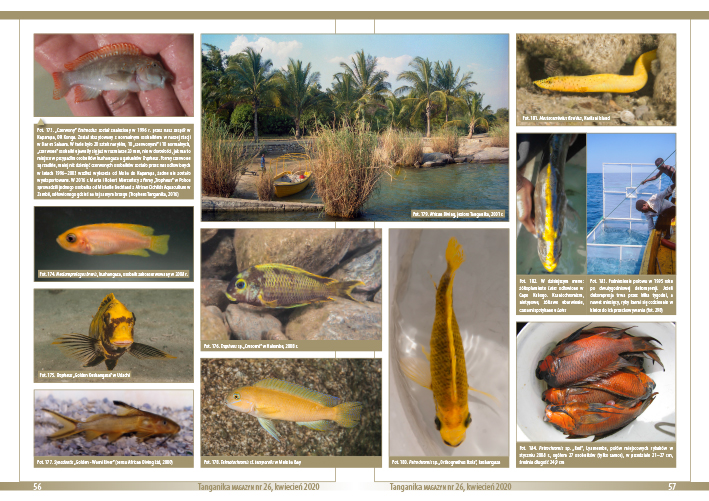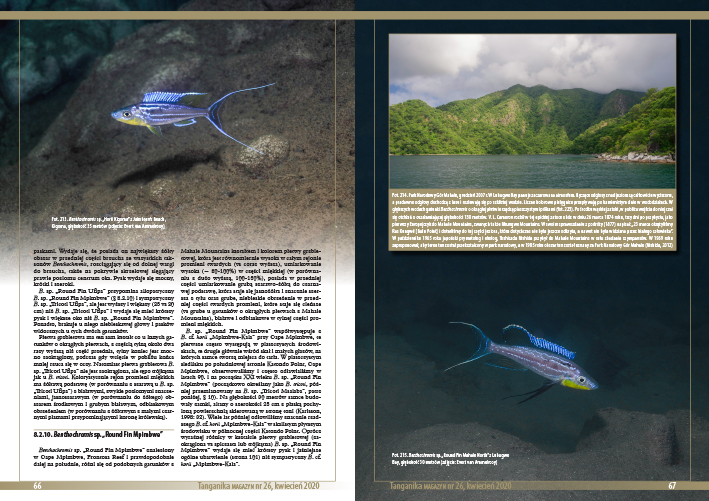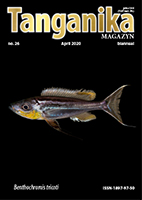
Monography – English version, 124 pages, 380 photos
- Benthochromis tricoti and its congeners, including a description of selected research projects and a brief history of African Diving, incorporating field observations and collection efforts – Magnus Karlsson, Mikael Karlsson
Monografia – język polski, 128 stron, 380 fotografii
- Benthochromis tricoti i jego krewni, wraz z opisem wybranych projektów badawczych i krótką historią African Diving, w tym obserwacji terenowych i działań związanych z odławianiem ryb – Magnus Karlsson, Mikael Karlsson
……………………………………………………………………………………………………………………………….
Review of Tanganika MAGAZYN no. 26 by Wolfgang Staeck
Magnus Karlsson & Mikael Karlsson (April 2020): Benthochromis tricoti and its congeners. Including a description of selected research projects and a brief history of African Diving, incorporating field observations and collection efforts. Tanganika Magazyn 9, no. 26 (Kraków, Poland), A4 format, 460 g, 124 pages, 380 photos, several maps and diagrams, ISSN-1897-97-50: 14 €/16 US$ (plus 9 €/ 13 US$ postage).
The 26th issue of the journal Tanganika MAGAZYN, published twice a year in Kraków (Poland), focuses on the cichlid genus Benthochromis endemic to Lake Tanganyika. The periodical was founded in 2007 by Marta and Robert Mierzeńscy and is still published by both. It is worldwide the only aquarium magazine exclusively containing articles about the East African Lake Tanganyika and its fish fauna. In the 13 years of its existence, the journal has become an insider tip not only for cichlid enthusiasts but also for scientists interested in the fish fauna of the lake, due to the high level of its content and the quality of the published photos.
The authors of the 26th edition of the periodical are the brothers Magnus and Mikael Karlsson from Sweden. Both lived in Tanzania for 25 years. From 1987 to 2003, they collected cichlids for their export company African Diving located on the central east coast of Lake Tanganyika at Kabwe and Udachi. Later, between 2007 and 2012, the two went on several expeditions, some of which lasted several months. The aim of these expeditions was to study the cichlids distributed on the east coast of the lake, to take an inventory of them, to document all the fish by underwater photos and to determine their exact geographical distribution.
The article in Tanganika MAGAZYN focuses not only on the three formally described Benthochromis species, but also on a dozen additional Benthochromis forms. The text contains the history of their discovery, collecting sites, distribution, reasons for their delimitation, diagnostic characters and a detailed description, which is supplemented by numerous aquarium and outstanding underwater photos. This preliminary work finally results in the proposal of a hypothetical family tree that reflects the phylogeny of the Benthochromis forms distinguished by the two authors (p. 103f).
However, the article is not only a monograph on the genus Benthochromis, but, as the title suggests, much more; and this makes the issue one of the most important recent publications on the fish fauna of Lake Tanganyika. The text begins with an informative and carefully investigated overview of historical research projects, the results of which had considerably expanded the knowledge about Lake Tanganyika cichlids. This chapter also includes a detailed appreciation of the unjustly neglected important limnological, ecological, ethological and taxonomic scientific pioneer studies that have been carried out by Japanese ichthyologists at Lake Tanganyika since the late 1970s.
One of the particularly interesting highlights of the article in Tanganika MAGAZYN is the detailed description and careful documentation of several research expeditions, during which the authors not only discovered numerous previously unknown geographical variants of cichlids, but also new species, three of which have been formally described so far. The results of these studies, mostly published for the first time in the text, are a valuable contribution to the knowledge about the diverse cichlids of Lake Tanganyika.
Important new scientifically significant findings are also contained in the 12th chapter of the text, which summarizes the currently available information on the deep-water species and genera that mostly live exclusively in the lower zones of Lake Tanganyika. A particularly exciting reading for me was the detailed description (preceding that chapter) of the preparation of the project to catch deep-water cichlids in a depth of 140 meters and to transfer them alive and unharmed into aquariums. Although affected by several setbacks, the plan was ultimately successfully realized.
Up to now, the phenomenon of polychromatism in the form of yellow and black piebald or monochrome orange specimens is mainly documented from Lake Malawi Lake Victoria. That is why the first detailed documentation of the existence of such polychromatism in several cichlid genera of Lake Tanganyika is not only of scientific but also of aquaristic interest. In Tanzania such colours morphs, which in the article are documented in several photos, are called Kushangaza (Swahili = surprising).
In the last chapter (§ 15), both authors describe vividly and with many interesting details the personal experiences that they had as collectors and exporters of Lake Tanganyika cichlids during a quarter of a century at the Lake. During this time permanent challenges, repeated setbacks, bureaucratic hurdles, changes caused by technical progress as well as new approaches and plans have had a lasting effect on their lives. These descriptions give the reader a comprehensive impression of the prerequisites required for the successful engagement in these activities, for example, above all an extraordinarily high frustration threshold.
Twenty-five pages of the booklet are plates containing between two and eight photos. This rich illustration contributes significantly to the quality of the publication, because the pictures not only explain many of the descriptions and statements in the text, but also document the new findings. Many of the not previously published illustrations document for the first time the appearance of the cichlids, which the two authors discovered on their expeditions.
In different contexts, both authors critically examine theses and theories that Ad Konings has put forward in his publications. These include the criteria he used to define distinct species, his synonymisation of several nominal species, his provisional naming of undescribed cichlids and his outdated distinction of subspecies. The two authors’ arguments offer the reader interesting food for thought. This also applies to the discussion of the underestimated importance of ethological and ecological features for the delimitation and distinction of phenotypically similar allopatric forms of Lake Tanganyika cichlids.
A six-page table containing 256 nominal species and subspecies of Lake Tanganyika cichlids is extremely helpful in providing more detailed information, as the original name, author, year of publication and relevant subsequent references are mentioned for each of them. The same applies to the unusually extensive eleven-page bibliography, which is a comprehensive collection of information as it lists 563 books, articles and web pages. Finally, a treasure trove of largely unknown ecological and ethological studies and their results is the compilation of one hundred essays in Appendix 5, which were published in English by Japanese scientists.
I can highly recommend the 26th issue of Tanganika MAGAZYN not only to fish keepers interested in Lake Tanganyika cichlids, but to ichthyologists as well, for the booklet is an important publication on these cichlids and provides plenty of valuable sources of information about the Lake’s diverse fish fauna.
Wolfgang Staeck
